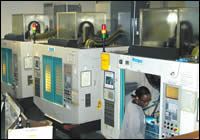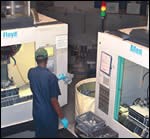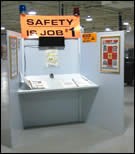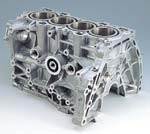Vertical Machining Centers For Volume Production
At this model plant for lean manufacturing, Parker Hannifin personnel became convinced that the simple approach was the strongest choice for the application. Part of the lesson learned at this plant is that the most difficult part of going lean may lie in the discussion.
Share




Parker Hannifin’s plant in Beaufort, South Carolina, makes truck engine components—units for fuel filtration, oil filtration and cooling. The plant is part of the company’s Racor division. To produce well in excess of 1,000 assembled products on a busy day, the plant has to be able to machine almost 10,000 cast aluminum workpieces daily. That demand might tend to suggest some traditional high-volume machining approach, such as transfer machines or horizontal machining centers. But the management of this plant, and company managers in other locations, ultimately became convinced of an alternate view—that the right solution for this application would come from simple, compact 30-taper vertical machining centers instead.
Joe Juliano, the plant’s engineering services manager, is one of the people who had to be convinced. When the new production process was being conceived 3 years ago, he was an advocate for horizontal machining centers, and he was prepared to fight for this approach. All that he had read about lean manufacturing suggested to him that this style of machining fit best with Parker Hannifin’s priorities for lean production in the new plant. A vertical was a low-cost machine for small volumes, and a horizontal was a more sophisticated machine better suited for higher volumes and higher demands—or so his thinking went. Only when he had a chance to see vertical machining centers running high-volume parts in a Toyota supplier’s facility did he recognize how well vertical machines would fit with his own application.
The priorities for that application can be summarized plainly. The plant needs the productivity to meet customers’ demands and the responsiveness to react to changes. Verticals meet the productivity requirement because their low unit cost lets the shop run more spindles for the money, compared to the other approaches. These machines meet the responsiveness demand because they are, to put it simply, simple. They can be brought on- and off-line with little difficulty; their work can be exchanged between machines; and adding an additional vertical machine as the demand warrants is relatively inexpensive.
The stress on simplicity in this process can’t be overstated. As a “model lean plant” for the company, the Racor facility is one of the most prominent plants within Parker Hannifin, even though the plant is not one of the more automated facilities, nor is it one of the more “high tech.” Parts arriving at each vertical machining center are not machined in a single setup. They are transferred from machine to machine. And work-handling devices don’t perform this transfer automatically, but instead parts are transferred piece by piece from machine to machine by human hands.
One consequence of this approach, says Mr. Juliano, is that the workholding is at least as important to this process as the machine tools.
Workholding And Handling
The plant has vertical machining centers grouped in three cells. One of the details the company wishes to keep secret is the precise number of machining centers used in this plant—but the number is between 10 and 20. Each of the three cells runs a particular set of part numbers, and different part numbers use a particular cell in different ways.
Sometimes a part goes to three machines in sequence. Sometimes two machines both perform a long first operation in parallel, while a third machine performs the short second operation all alone. And sometimes, one machine out of three sits idle, because only two machines are needed to run a particular part. Keeping all of the machines cutting is not a priority in this plant. Meeting quality demands, meeting quantity and delivery demands that change daily, and keeping labor efficiently engaged are all higher priorities than this.
Here is how a machining cycle works: An operator walks to a machine tool with a workpiece in hand. The machine tool door is open because the previous machining cycle has just been completed. The operator unloads the current piece and loads the next piece. Walking to the next machine, the operator hits a switch that triggers the door to close, the fixture to clamp and the machining cycle to begin. The operator then arrives at the next machine with the partially completed workpiece in hand. The door to that machine is open, and the sequence begins again.
Is it costly to use human labor in this way, mechanically performing workpiece transfer? In cases where the work transfer truly is mechanical, the answer may be yes. The plant will evaluate automation for some of its work transfer in the future. However, the value of every operator extends beyond the movement of parts. All employees in the machining cells have duties apart from those cells. And within the cell, one of the employee’s functions is to perform a visual inspection of every completed part. A quick look to confirm that everything seems right is an important element of the shop’s quality control system, and human attention is a particularly effective tool for accomplishing this step.
But still, why not at least use a work switcher at each machine, to allow one workpiece to be loaded while the machining cycle is running another piece?
Mr. Juliano says the answer to this question gets back to simplicity. That work switcher would become one more device to maintain, and one more element of the process that might break down. The solution the plant chose instead was to install workholding that can be loaded and clamped quickly, so that the delay between cycles is brief.
Hydraulically actuated workholding was supplied by Master Work-Holding of Morganton, North Carolina. For each part at the Racor plant, the fixture consists of off-the-shelf workholding components that are arranged on a standard subplate. The plate has manifolds for air and hydraulic connections so the fixtures have no tubing exposed. Each fixture includes a seat sensor that confirms the correct part has been loaded, along with a mechanical tool break sensor that reaches around to touch the tool just before each machining cycle begins. Worktables on the machining centers are wide enough so that two fixtures, for two different part numbers, can be kept in place on each machine.
Most of the vertical machining centers here are “brothers,” both literally and figuratively. The many 30-taper Brother-brand machine tools were installed by Yamazen (as were a pair of 40-taper machining centers built by NTC). An integrator of lean manufacturing systems based in Schaumburg, Illinois, Yamazen was responsible for taking Mr. Juliano to see the Toyota supplier. The process there, like the process that was put in place at the Racor plant, relies on many identical machining centers. This redundancy provides broad freedom to transfer parts and programs from one machine to another, and it even provides the freedom to transfer components of the machines themselves. In the toolroom of the Racor plant is a less critical Brother machine that isn’t needed daily. On one or two occasions, this machine has temporarily surrendered some critical machine component in order to keep a brother Brother cutting while its own replacement component was on the way.
Going Vertical
Mr. Juliano summarizes why the plant chose vertical machining centers over horizontal machining centers or rotary transfer machines. First, he says, the simplicity ultimately translates to time and cost savings. The more simple the machine, the faster it can be repaired and brought back to service when a problem occurs.
Another consideration was flexibility. This plant faces the prospect of a major design change every 4 years, along with the possibility of production shifts or minor design changes at any time. For raw machining productivity, a rotary transfer machine would have been the plant’s best choice. However, plant personnel were concerned that rotary transfer machines would not allow them to quickly implement process changes.
By contrast, the strength of horizontal machining centers would have been the freedom to use tombstone fixtures to set up a large number of workpieces or part numbers at once. Mr. Juliano says that strength would have been valuable if the plant had to maintain a large mix of dedicated fixtures, or if the plant had to run unattended for long stretches. But neither condition applies to this application. Meanwhile, the more expensive horizontal machine has just the same number of spindles as a vertical machine.
Measured in terms of dollars per spindle, vertical machining centers showed their advantage. According to estimates Parker Hannifin received, the same amount of money that purchased all of the fully equipped verticals for this application would have purchased just four comparably equipped horizontal machining centers, or else six spindles in a rotary transfer arrangement.
That low cost per spindle was particularly useful as the plant was ramping up this process. Not all of the funding for the plant became available immediately. In the early stages, the plant was able to buy enough spindles (that is, enough machining centers) that it could put a reasonably well-developed process in place and begin production before all of the funding had been allocated.
Clean Start
This process was installed in a building that already existed. Other than that, the plant is brand new.
Mr. Juliano worked in the building before. The process that filled the plant back then produced aircraft components. These were big parts with big leadtimes that were made on big machines. But then the plant was closed, the equipment was sold off, and for more than a year, Mr. Juliano showed up for work in an empty facility. Personnel on the production floor were preparing for the transition. Just the cleaning alone (if lean manufacturing is clean, filter manufacturing is even cleaner) took more than 6 months to accomplish.
It was during this transition period that the discussions about how to equip the new plant occurred. Mr. Juliano and plant manager Brian Hook were active participants. Both men say that the greatest obstacle to recognizing the value of vertical machining centers in this process did not lay in the analysis, but in the culture. This lesson is perhaps the most striking one that they took away from the experience.
Every organization has legacies. There are legacies of equipment, but there are also legacies of thinking. Some of the most important work that a company can do to further its own long-term success is to tear down assumptions, not just to build the product. For those associated with the Parker Racor plant, the plant’s transition period involved challenge, persuasion and argument. In short, there was valuable work happening here, even while the facility had no machines.
This plant started more free of legacies than most plants that try to undergo process improvements. The plant got the opportunity to design a process from the ground up, instead of adapting equipment and processes that were already in place. What’s more, this plant was identified from the beginning as a model lean plant, meaning it was meant to illustrate to the rest of Parker Hannifin how lean manufacturing might be done. But even at that, to see the value in a solution so different from the company’s traditional approaches, and then to convince all of the stakeholders of the value of that solution, proved to be a long, unpredictable and occasionally frustrating process.
Mr. Juliano is convinced that best solution for this plant won, but it might not have been that way. He himself had to be persuaded. Without the extra freedom made possible by the corporate encouragement and a clean slate, it’s not clear that this plant would have arrived at the same solution. Getting to a better way is hard work. And the limit on a plant’s efficiency may well be determined by the assumptions that go unexamined because they are so difficult to see.
Read Next
Discovering 30-Taper Machines
They are now capable of handling many of the jobs traditionally done on larger machines. As this account shows, the development says a lot about what's happening in metalworking right now.
Read More5 Rules of Thumb for Buying CNC Machine Tools
Use these tips to carefully plan your machine tool purchases and to avoid regretting your decision later.
Read MoreBuilding Out a Foundation for Student Machinists
Autodesk and Haas have teamed up to produce an introductory course for students that covers the basics of CAD, CAM and CNC while providing them with a portfolio part.
Read More































